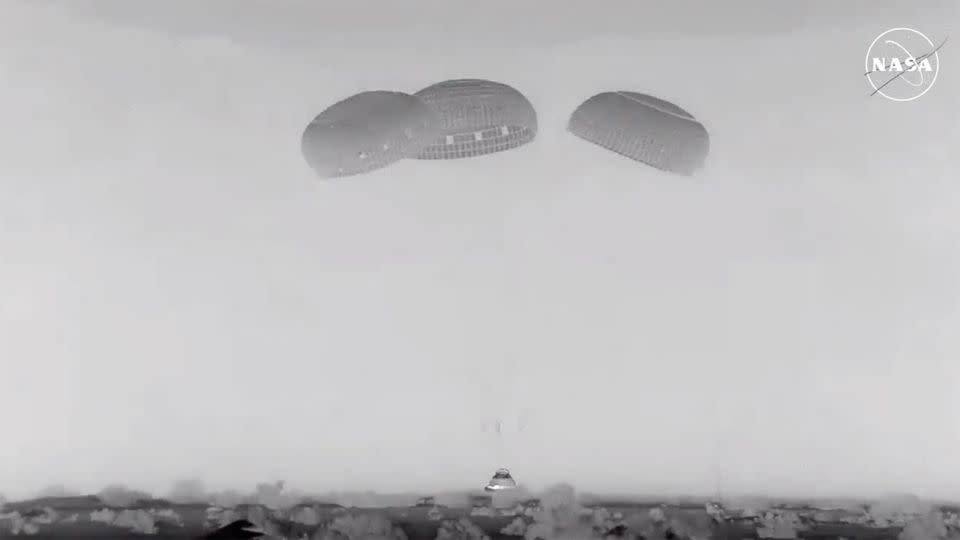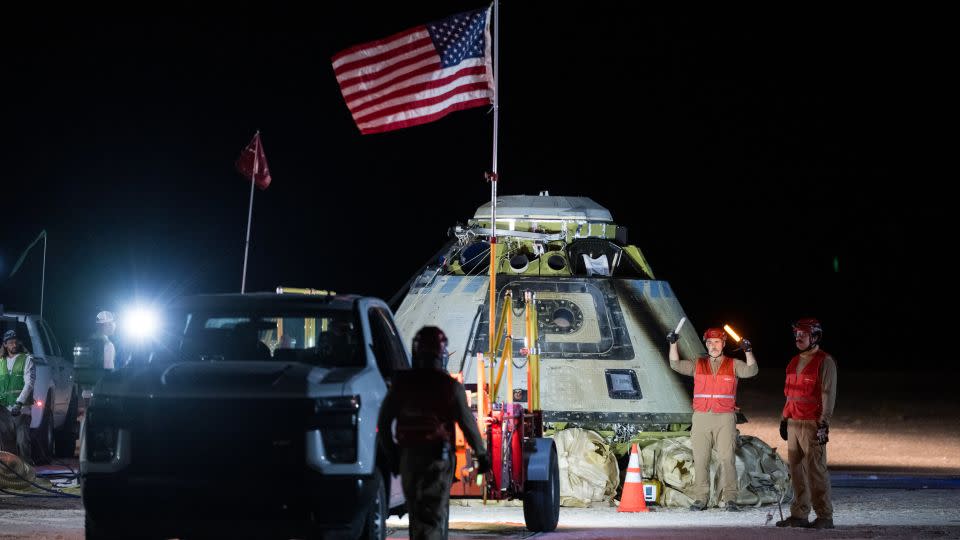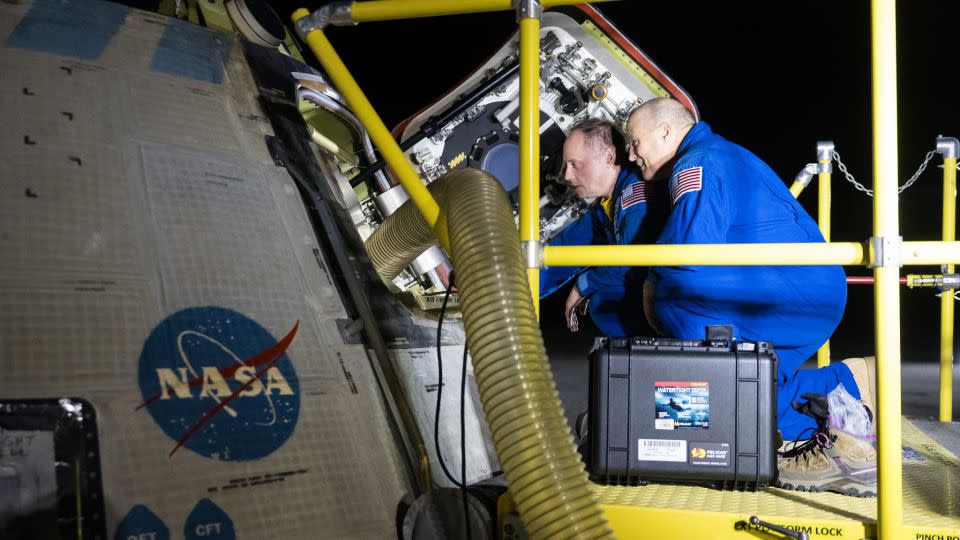Relive the Boeing Starliner capsule’s return home as it happened.
Boeing’s Starliner capsule returned from the International Space Station Friday evening — concluding its nearly three-month stay in space. But it flew back to Earth with an empty cabin, leaving behind two test pilots who must now remain on the station for another five or six months.
The Starliner left its docking port at the space station just after 6 p.m. ET, according to NASA. The capsule spent about six hours free-flying through orbit as it slowly made its descent toward home.

Before the capsule departed, Butch Wilmore and Suni Williams — the two NASA astronauts who flew Starliner to the space station back in June — wished the spacecraft, nicknamed “Calypso” by Williams, luck on its long-awaited and unexpected journey home.
“It is time to bring Calypso home,” Williams said to mission control Friday evening. “You have got this. We have your backs, and you’ve got this. Bring her back to Earth.”
Close to midnight, the capsule reached one of the most important and treacherous legs of its test flight: reentry. The milestone required the Starliner to carefully orient itself as it plunged into the thickest part of Earth’s atmosphere while still traveling at orbital speeds — typically more than 17,000 miles per hour (27,400 kilometers per hour).
As with every spacecraft that returns from orbit, the pressure and friction of reentry put immense strain on the vehicle. The process could have heated up the spacecraft’s exterior to more than 3,000 degrees Fahrenheit (1,649 degrees Celsius).
Then, as the Starliner fell through the air, a set of parachutes — which Boeing redesigned and tested as recently as January — slowed the capsule before the vehicle deployed airbags for a gentle touchdown on terra firma.
Starliner is the first US-made capsule to parachute to a landing on the ground rather than splash down in the ocean. Boeing hopes that approach will make it easier to recover and refurbish the spacecraft after flight.


The vehicle landed in New Mexico at the White Sands Space Harbor, an area within a vast missile range of the same name that was previously used to train NASA space shuttle pilots. Starliner hit its mark at 12:01 a.m. ET Saturday, according to the space agency.
“I want to recognize the work the Starliner teams did to ensure a successful and safe undocking, deorbit, reentry and landing,” said Mark Nappi, vice president and program manager of Boeing’s Commercial Crew Program. “We will review the data and determine the next steps for the program.”
During a news briefing after the landing, NASA’s Commercial Crew Program manager Steve Stich said that it’s not clear exactly what the path forward for Starliner looks like — or when the spacecraft could return to flight. That will “take a little time,” he said.
However, he added: “Now we’ve landed a capsule in the US on land. The entry in particular has been darn near flawless, so that — I wouldn’t say it surprised me — but as I step back and think about the mission, the entry itself was just, and the deorbit burn was spot on.”
Stich also acknowledged that if on-the-ground modeling were perfect, perhaps NASA would have trusted Starliner to bring Wilmore and Williams home on the vehicle’s return flight.
“If we’d had a model that would have predicted what we saw tonight perfectly, yeah, it looks like an easy decision to go say we could have had a crewed flight — but we didn’t have that,” Stitch said.
“From a human perspective, all of us feel happy about the successful landing,” he said. “But then there’s a piece of us, all of us, that we wish it would have been the way we had planned it. We had planned to have the mission land with Butch and Suni on board.”
Starliner’s troubled test flight
At first, NASA officials expressed confidence they could pinpoint Starliner’s issues and hash out a plan to safely return the vehicle with crew. But two lingering issues ultimately derailed those plans.
Concern about Starliner’s ability to hold a precise orientation while reentering Earth’s atmosphere — given several issues that cropped up during the first leg of its trip — was one of the reasons NASA opted not to fly Starliner’s crew home with the vehicle. Instead, Williams and Wilmore will stay aboard the space station and catch a ride home on a SpaceX capsule in 2025.
First, a series of helium leaks sprang up during Starliner’s outbound flight in early June. Helium is used to pressurize some of the vehicle’s thrusters, which help the spacecraft stay oriented in space, and problems with some of the helium spilling out delayed this crewed test mission even before takeoff.
Separately, five of Starliner’s 28 “reaction control system” (RCS) thrusters abruptly stopped working en route to the space station. Four were ultimately recovered, but at least one remained out of service for the entire mission.
NASA and Boeing kept the Starliner in space for weeks as they worked to understand those problems, stretching William’s and Wilmore’s stay from the expected length of about eight days to months.
At one point, NASA and Boeing said they believed they understood the likely cause of Starliner’s problems. The “doghouses,” or structures that contain propulsion equipment, were flying hotter than expected, causing some Teflon seals within the thruster systems to bulge — restricting the flow of propellant and causing the RCS thruster outages. Separately, officials said, the helium leaks might have been caused by seals that became degraded by exposure to propellant vapor.
Determining the root cause of a spacecraft issue, however, is not a perfect science.
And even if the issues were well understood, the Starliner team had to face the fact that it would never get to inspect the propulsion system on the actual vehicle in space. It was impossible to survey the problem as the Starliner sat attached to the space station.
What’s more, the unit that houses the troubled RCS thrusters and the helium leaks — called the service module — was not intended to survive the trip home. Instead, the service module, which is a cylindrical attachment at the bottom of the crew cabin, was designed to be ejected and disposed of on the way back to Earth. And it did just that on this mission.
The risks ahead
The ambiguity surrounding what exactly happened to the service module’s components was one key factor in NASA’s decision to fly the vehicle home without its crew.
“The bottom line relative to bringing Starliner back is — there was just too much uncertainty in the prediction of the thrusters,” Stitch said on August 24. “It was just too much risk with the crew, and so we decided to pursue the uncrewed path forward.”
During Starliner’s perilous return to Earth, the capsule did have other types of thrusters meant to help the vehicle keep its orientation as it traveled through space.
Alongside the 28 RCS thrusters are 20 “Orbital Maneuvering and Attitude Control” — or OMAC — thrusters, each of which has about 17 times the thrust of an RCS thruster.
But during a previous news conference, Stich described how the problems already identified on the Starliner’s service module might combine to create a disaster scenario.
“The worst case would be some integrated failure mechanism between the helium leaks and the RCS thrusters,” Stich said. “For a nominal de-orbit burn, we fire 10 OMAC thrusters in each of the four doghouses, and then the RCS jets are just there to hold the orientation.”
During Starliner’s final descent Friday, a series of checks carried out by teams on the ground showed that one of the thrusters on board the Starliner capsule itself had petered out.
Previous thruster outages that troubled the Boeing and NASA teams revolved around hardware located on Starliner’s service module — a cylindrical attachment that sits at the Starliner capsule’s base.


‘Remain vigilant’
During the August 24 news briefing, NASA officials also indicated that Boeing disagreed with some of the space agency’s risk assessments.
There was “just a little disagreement (between NASA and Boeing) in terms of the level of risk,” Stich said. “It just depends on how you evaluate the risk. … We did it a little differently with our crew than Boeing did.”
But Ken Bowersox, NASA’s associate administrator for the Space Operations Mission Directorate, added that the company had left the final decision up to NASA “because of our wider view of all the risks involved.”
Boeing said as recently as August 2 that its “confidence remains high” that Starliner could return with crew. But since NASA announced its decision to fly the capsule home without astronauts, the company has said only that it is focused on “executing the mission as determined by NASA, and we are preparing the spacecraft for a safe and successful uncrewed return,” according to an August 24 statement.
How Starliner performed on its trip home could have broader implications for the future of the Boeing program. Already, the company has lost more than a billion dollars correcting issues with the vehicle, through years of delays, development setbacks and errors in flight.
It is not yet clear whether NASA will require Boeing to repeat this test flight — or if the space agency will consider certifying the spacecraft for regular flight after the mission’s safe landing.
Boeing has already had to repeat one test mission, an uncrewed test flight that took off in 2019. Software issues prevented the vehicle from entering the correct orbit and even reaching the International Space Station, prompting NASA to require Boeing to repeat the excursion in 2022.
Sign up for CNN’s Wonder Theory science newsletter. Explore the universe with news on fascinating discoveries, scientific advancements and more.
For more CNN news and newsletters create an account at CNN.com
